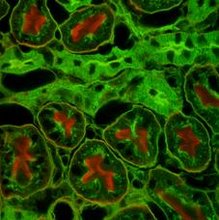Protein estimation by Barford’s method.
PRINCIPLE:
It is a rapid and accurate method for estimation of protein concentration. When compared to Lowry’s method, it is subjected to less interference by common reagents and non-protein components of biological sample.
The assay relies on the binding of the dye Coomassie blue G250 to protein. The quantity of protein can be estimated by determining the amount of dye in the blue ionic form. This is usually achieved by measuring the absorbance of the solution at 595nm or 625nm.
PROCEDURE:
1) Pipette standard BSA (0.5mg/ml) & test sample as indicated in table in duplicates.
2) Adjust the volume to 0.2ml with distill water.
3) Add 3ml of Barford’s reagent & mix it thoroughly. Incubate at R.T. for 10 min.
4) Read the optical density on spectrophotometer at 595nm/625nm or on a Colorimeter using a suitable filter & record the reading.
5) Read the optical density on spectrophotometer at 595 nm/625nm or on a Colorimeter using a suitable filter and record the readings.
6) Construct a calibration or standard curve by plotting avg. optical density reading on ‘y’ axis against std. Protein concentration on ‘x’ axis.
7) Calculate the concentration in the test sample using the following formula.
Protein conc. In test sample = X/V mg/ml
Where, X= value from graph in mg V= volume of sample in ml
Result: - From the Std. Curve, determine & Report Conc. Of protein in the test sample.
Subscribe to:
Post Comments (Atom)


4 comments:
this is helpful for me .....and i lik ur blog...
information is sufficient... thank you!!
May i know is there any difference between barford's method and bradford's method
can you please show some reference where you've got this protocol. what's the difference between barford's method and bradford's method?
Post a Comment